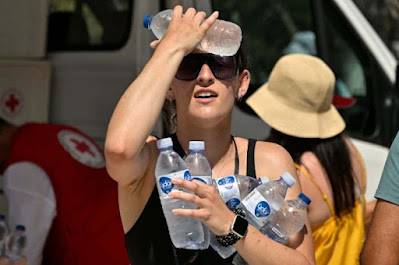By ignoring declining air pollution, regional climate models have greatly underestimated how hot Europe's summers and heatwaves will become.
Summers and heatwaves in Europe will be even more sweltering than feared. The regional climate models relied on by planners greatly underestimate summer heat because they don’t factor in more intense sunshine due to falling air pollution, a study has shown.
 |
| A woman cools off with water distributed by the Red Cross charity near the entrance of the Acropolis in Athens, Greece, in July 2023 Louisa Gouliamaki / AFP/ Getty |
“If models don’t take air pollution changes into account, they will underestimate the intensity of future heatwaves even more than they underestimate mean summer warming,” says Dominik Schumacher at ETH Zürich in Switzerland. “It’s problematic because a lot of European countries strongly rely on these simulations to plan for the future.”
Running global climate models requires a lot of expensive computer time, so researchers often look only at smaller regions, allowing them to run more detailed models. These higher-resolution regional models are typically relied on by governments, as their projections for specific locations are supposed to be more accurate than global models.
“The regional models are used in many countries to inform future changes, so really should do a good job capturing the observed warming,” says Schumacher.
But when he and his colleagues compared the observed summer warming in Europe between 1980 and 2022 with the projections of global and regional climate models, they found the regional models underestimated the actual warming by more than 1°C, on average. The global models did better, only underestimating by an average of around 0.5°C.
One explanation is the models are missing changes in air circulation patterns that are bringing more heat into the region. When Schumacher excluded the effects of circulation changes, this brought the global models nearly in line with the observed warming, but the regional models still underestimated the changes by more than half a degree on average.
Next, the researchers looked at what assumptions the models make about sunlight intensity. They found that most regional models didn’t account for the fact that sunlight intensity is increasing in Europe as levels of air pollutants decline. The few models that do factor this in match the observed warming.
“The key reason why these regional climate models failed to reproduce this human-induced warming is that most of them assume that air pollution is constant,” says Schumacher, who presented the finding at a meeting of the European Geosciences Union in Vienna, Austria.
This means the regional models are underestimating how much warmer European summers will be by 2100 by more than 2°C, the team concludes. The underestimation of heatwaves is even greater, because during heatwaves there are usually clear skies and even more sunshine than normal, says Schumacher.
Regional models will now all be altered to take account of falling air pollution, but this will take time, he says.
It has been suggested that falling air pollution is partly responsible for the record-smashing global temperature rises in the past year or so, which were even higher than expected due to rising greenhouse emissions. Schumacher says the team’s study doesn’t shed any light on this question, but that other studies presented at the meeting found this isn’t the case.
He also stresses that his team’s findings shouldn’t be taken to mean that air pollution is a good thing, pointing out that it is estimated to cause millions of deaths every year.
Reference:
European Geosciences Union meeting 2024 DOI: 10.5194/egusphere-egu24-18153





0 Comments